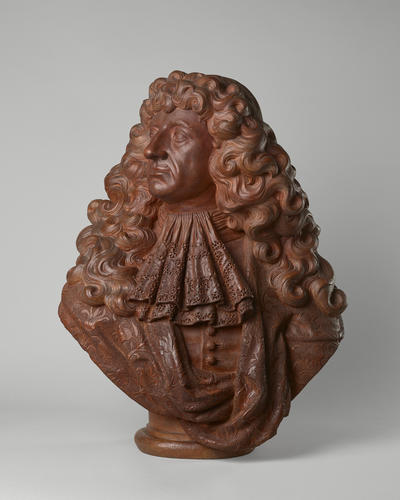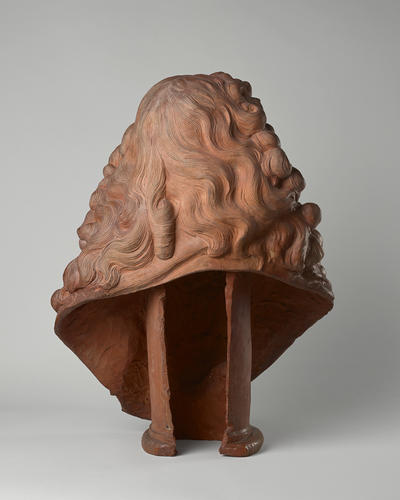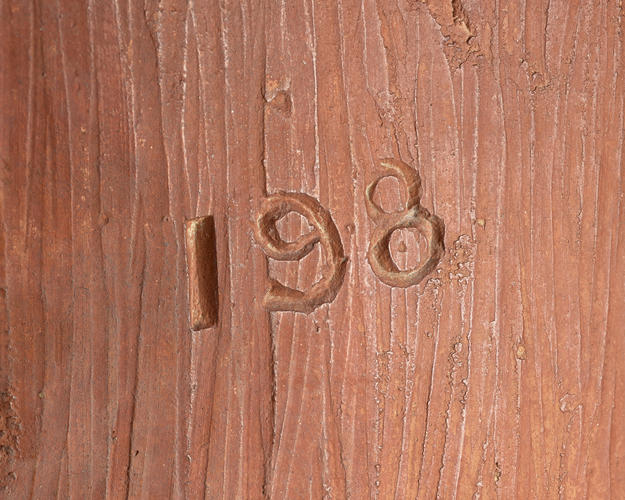-
1 of 253523 objects
Charles II (1630-1685) 1675-80
Terracotta | 70.0 x 56.0 x 32.0 cm (whole object) | RCIN 39248

Attributed to Edward Pearce (c. 1630-95)
Charles II (1630-1685) 1675-80

Attributed to Edward Pearce (c. 1630-95)
Charles II (1630-1685) 1675-80

Attributed to Edward Pearce (c. 1630-95)
Charles II (1630-1685) 1675-80



-
A terracotta bust of Charles II, his head turned to the left, wearing a lace cravat and brocade cloak across his shoulders. On a plain circular column.
This bust was probably made as a model for a final marble version, although no copies from it are known. The king is depicted wearing contemporary dress decorated with a pattern of stylised tulips, a rich lace cravat and a wig. His serious expression and the positioning of his head, turned to the right and slightly raised, emphases his dignity and authority. The carver was probably Edward Pearce (or Pierce), an architect and sculptor working in the building boom that followed the Restoration and the Great Fire of London. His practice encompassed both architectural design for ecclesiastical and domestic buildings and the execution of ornament in wood and stone, some of which was carried out at the royal palaces. He worked for lengthy periods on the decoration of the royal palaces and their gardens, especially at Hampton Court. He was the master mason, or main building contractor, for four of Sir Christopher Wren's churches in London and for parts of St Paul's Cathedral.
The bust seems to have been made during the sitter's lifetime. The unusual format and turn of the head can be paralleled in paintings of Charles II’s time, where the sitter’s body is often seen in profile. Pearce made few busts, but that of Thomas Evans, in marble, dated 1688, in the collection of the Painter-Stainers Company, is in many ways close to this example. There are notable similarities in the arrangement of the clothing and the cutting and pouncing to suggest the different textures of the textiles. Pearce's marble bust of Dr Baldwin Hamey, MD, in the collection of the Royal College of Physicians, dated 1675, also displays similar characteristics in the treatment of clothing. On the basis of this likeness, it has been suggested that the terracotta probably dates from 1675-80. The high skilled modelling of a stoneware portrait bust of Prince Rupert, now in the British Museum, has also been attributed to Pearce.
The textile details on this bust were achieved with a fastidious hand in the clay. The cravat has an almost chip-carved quality with very sharp triangular voids, while the pouncing of the ground of the cloak relates to wood carving conventions as applied to picture frames or mouldings.
Until 1938 the bust was covered by a 'bronze treatment', which King George VI and Queen Elizabeth asked the Surveyor of The King's Works of Art, Lord Gerald Wellesley, to have removed. The work was undertaken by Messrs Paine and Clarke in the workshops of the Victoria and Albert Museum. This cleaning process revealed a large crack across the bust and a loss in the neck, which were made good at the time. After the return of the bust to Windsor, the queen expressed herself ‘delighted’ with its appearance.
This episode enables a link to be made with an account in the Royal Archives for a bronzed bust purchased for George IV in May 1829. Although the bust was not identified as terracotta, the bill includes £2.16.6 for ‘Cleaning off the old Bronze and preparing and rebronzing ditto.’ This confirms the supposition that the bronzing almost certainly dates from the first quarter of the 19th Century. The vendor of the bust, Thomas Fairs (1796–1848), was a house-painter, listed in an 1827 London Directory as ‘Painter to His majesty’, at 23 Mortimer Street. He was also a dealer with antiquarian interests. To judge from the sale organised over four days by his executors following his death in 1848 (by which time he was styled ‘Decorator to Her Majesty’) his stock-in-trade was architectural salvage. It included panelling, stained glass, grates and chimneypieces, and substantial furniture variously described as ‘Louis XIV’, ‘Tudor’, ‘Elizabethan’ and ‘Venetian’.14 On the fourth day there were ‘sculpture busts, bas-relief &c.’ but it seems that this sort of material was not central to his operation.
Text adapted from Charles II: Art and Power (2017) and Sculpture in the Collection of His Majesty The King (2025).Provenance
Purchased for George IV in 1829 by Lord Farnborough from Thomas Fairs; Carlton House; Windsor Castle; in store in 1866; moved to King Charles II’s Dining Room during the reign of King Edward VII
-
Creator(s)
(nationality) -
Medium and techniques
Terracotta
Measurements
70.0 x 56.0 x 32.0 cm (whole object)
Category
Object type(s)